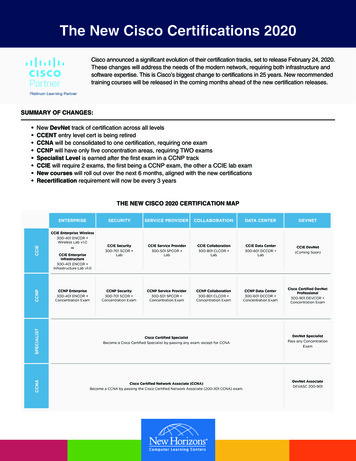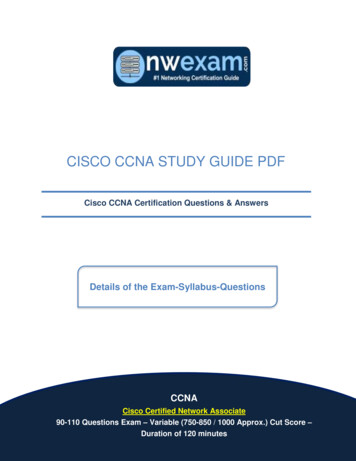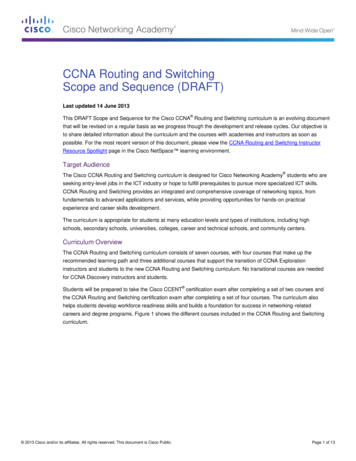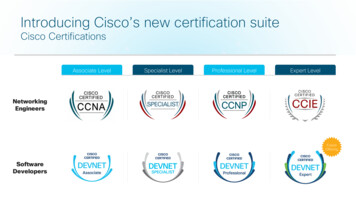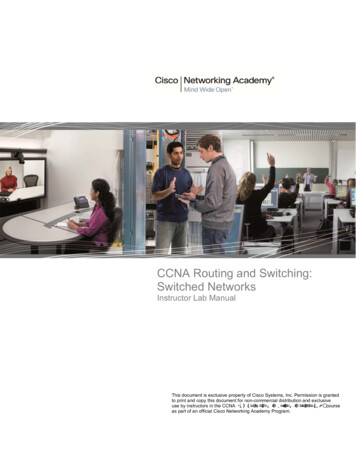
Transcription
Ccna routing and switching syllabus pdf download
Ccna routing and switching syllabus pdf downloadThis site was designed to help you pass the current CCNA 200-301 exam, but it can also be used as a reference for anything networking related. You’ll find all the materials needed to study for your CCNA exam here.On the left side (or below on mobile) you’ll find a list of articles covering all the exam topics, organised into chapters. The first couple ofchapters describe some basic networking terms and devices, the later chapters go a little bit more in depth. You can start reading the articles from the beginning to work your way through the exam topics in a logical manner, or you can find a specific article that interests you.Also make sure to download our Free CCNA Study Guide PDF to get fullstudy notes in one book, and check out our Recommended CCNA Study Resources.So what are you waiting for? Choose a topic and start learning! We wish you luck! pdf download CCNA Routing and Switching Complete Study Guide: Exam 100-105, Exam 200-105, Exam 200-125 read CCNA Routing and Switching Complete Study Guide: Exam 100105, Exam 200-105, Exam 200-125 best seller CCNA Routing and Switching Complete Study Guide: Exam 100-105, Exam 200-105, Exam 200-125 CCNA Routing and Switching Complete Study Guide: Exam 100-105, Exam 200-105, Exam 200-125 txt CCNA Routing and Switching Complete Study Guide: Exam 100-105, Exam 200-105, Exam 200-125pdf CCNA Routing and Switching Complete Study Guide: Exam 100-105, Exam 200-105, Exam 200-125 ebook CCNA Routing and Switching Complete Study Guide: Exam 100-105, Exam 200-105, Exam 200-125 csv CCNA Routing and Switching Complete Study Guide: Exam 100-105, Exam 200-105, Exam 200-125 doc CCNA Routing and SwitchingComplete Study Guide: Exam 100-105, Exam 200-105, Exam 200-125 excel reading CCNA Routing and Switching Complete Study Guide: Exam 100-105, Exam 200-105, Exam 200-125 CCNA Routing and Switching Complete Study Guide: Exam 100-105, Exam 200-105, Exam 200-125 full book pdf download CCNA Routing and Switching CompleteStudy Guide: Exam 100-105, Exam 200-105, Exam 200-125 read CCNA Routing and Switching Complete Study Guide: Exam 100-105, Exam 200-105, Exam 200-125 best seller CCNA Routing and Switching Complete Study Guide: Exam 100-105, Exam 200-105, Exam 200-125 CCNA Routing and Switching Complete Study Guide: Exam 100-105, Exam200-105, Exam 200-125 txt CCNA Routing and Switching Complete Study Guide: Exam 100-105, Exam 200-105, Exam 200-125 pdf CCNA Routing and Switching Complete Study Guide: Exam 100-105, Exam 200-105, Exam 200-125 ebook CCNA Routing and Switching Complete Study Guide: Exam 100-105, Exam 200-105, Exam 200-125 csv CCNARouting and Switching Complete Study Guide: Exam 100-105, Exam 200-105, Exam 200-125 doc CCNA Routing and Switching Complete Study Guide: Exam 100-105, Exam 200-105, Exam 200-125 excel reading CCNA Routing and Switching Complete Study Guide: Exam 100-105, Exam 200-105, Exam 200-125 CCNA Routing and Switching CompleteStudy Guide: Exam 100-105, Exam 200-105, Exam 200-125 full book Sign Up to our social questions and Answers Engine to ask questions, answer people’s questions, and connect with other people. Have an account? Sign In Andrew Crouthamel Cisco CCNA Training Notes SOLD TO THE FINE [email protected] Cisco CCNA Routing and SwitchingTraining Notes 100-101 ICND1, 100-102 ICND2 200-120 CCNA Andrew Crouthamel 1 Andrew Crouthamel Cisco CCNA Training Notes Table of Contents Table of Contents About ShrikeCast and Andrew Crouthamel About Cisco Certification and CCNA Useful Networking Tools and Learning Resources When do I use a Network? What are Networks?The History of the Internet How the Internet is Designed How to Communicate Sizes of Networks Protocols OSI and TCP/IP Models All About Applications Common Protocols Roles of the Transport Layer TCP and UDP Protocols Internet Protocol and IPv4 Networks and Subnets Introduction to Routing IPv4 Basics IPv4 Address Types IPv4 SubnettingIPv6 Addressing Basics IPv6 Unicast and Multicast IPv6 Testing Connections Data Link Layer Basics Physical Layer Basics Network Media Topology Basics Ethernet Basics Address Resolution Protocol (ARP) Switch Basics IOS Device Basics IOS Command Basics Switch Configuration Basics Switch Security Basics Switch Port Security VLAN Basics 2Andrew Crouthamel Cisco CCNA Training Notes Creating VLANs VLAN Trunks VLAN Security Layer 3 Switching Routing Basics Routing Table Basics Router-on-a-stick Configuration Static Routing Basics Static Routing Configuration Dynamic Routing Protocols Basics Distance Vector Routing Protocols RIP Configuration Open Shortest Path First(OSPF) OSPFv2 Single-Area Configuration OSPF Multi-Area Basics OSPF Multi-Area Configuration EIGRP Basics EIGRP Configuration EIGRP Metrics and DUAL EIGRP Tuning and Security Access Control Lists (ACLs) Standard IPv4 ACL Configuration Extended IPv4 ACL Configuration Dynamic Host Configuration Protocol (DHCP) DHCPConfiguration Network Address Translation (NAT) NAT Configuration Spanning Tree Protocol (STP) Spanning Tree Configuration Redundancy Protocols Link Aggregation Basics Wireless Basics and Security IOS Naming Scheme IOS Licensing WAN Basics Serial Point-to-Point WAN Encapsulation PPP Configuration Frame Relay Basics Frame RelayConfiguration PPPoE Configuration VPN Basics GRE Tunnel Configuration 3 Andrew Crouthamel Cisco CCNA Training Notes 4 Syslog Basics SNMP Basics NetFlow Basics Credits About ShrikeCast and Andrew Crouthamel Started in 2011 to share IT knowledge Shrike comes from the bird Impales insect and small mammals on spikes to help itrip apart and preserve for later Andrew has been in IT for 10 years now CCNA CCNA Security CCAI VCP5 CompTIA Security CompTIA Network CompTIA A Majority has been involved in networking and security LinkedIn: About Cisco Certification and CCNA Current Cisco Certification Levels Entry Associate Professional Expert Architect Cisco Certification Tree Recertification policy Pass one test from same level or above, all certifications update CCNA 100-101 ICND1 (CCENT) Modules 1 & 2 of Cisco Networking Academy AND 200-101 ICND2 (CCNA) Modules 3 & 4 of Cisco Networking Academy OR 200-120 CCNA(ICND1 & ICND2) Modules 1 & 2 & 3 & 4 of Cisco Networking Academy Andrew Crouthamel Cisco CCNA Training Notes Useful Networking Tools and Learning Resources Wireshark - Packet Tracer GNS3 - PuTTY - sgtatham/putty/ KiTTY - TFTP32 - Angry IP Scanner - Cisco Learning Network - GNS Labs - When do I use aNetwork? World economies going global Instant communications across the world Facebook Twitter TV, Phone, Internet, everything uses networks Smartphones Communications Social Networks News Blogs Internet Radio Podcasts Instant Messaging Wikis VoIP eBooks (rise of Kindle and self-publishing) Banking Shopping Mail order catalogs Traditional stores Auction sites eBay Education revolution Online classes Online colleges 5 Andrew Crouthamel Cisco CCNA Training Notes Coursera & Udacity Business needs Remote access IPsec SSL-VPN Connections between locations Site-to-site IPsec VPN Gaming Online game matches Xbox Live PSN Online distribution Steam Rise of independent developers and publishing Internet of Things No longer PCs, everything getting connected QoS important What are Networks? Communication needs Sender and receiver Method Language Speed Confirmation Quality Acceptablequality needs to be determined More times data is transmitted, greater chance of corruption Size of data packages needs to be determined Reliability is key now Network elements Rules (Protocols) HTTP/HTTPS SMTP POP XMPP OSCAR SIP FTP Telnet SSH 6 Andrew Crouthamel Cisco CCNA Training Notes 7 Medium Wired Wireless Messages Segments Packets Frames Devices Switches Routers Network symbols Converged Networks The History of the Internet Victorian Internet Telegraph (1830-40s) Submarine cables (1850s-60s) Gave rise to phone networks Began in 1950s Mainframe computer connections Late 1960s into 1980s ARPANET (Advanced Research Projects Agency Network) 1969-1985 (latest 1989) Project of DARPA (Defense Advanced Research Projects Agency) Connected universities at first, military later Military split off with MILNET in 1983 E-mail, FTP, TCP/IP protocols Shut down around 1985 with NSFNETintroduction 1980s CSNET (Computer Science Network) 1981-1984 Project of National Science Foundation Used to connect institutions that could not get funding or authorization to connect directly into ARPANET Rose awareness for the national network NSFNET (National Science Foundation Network) 1985-1995 Project ofNational Science Foundation Provide connections for researchers to supercomputers funded by NSF Started with a 56Kbps backbone, upgraded to 1.5Mbps T1, then to a 45Mbps T3, OC3, OC12, OC48 Andrew Crouthamel Cisco CCNA Training Notes 8 BGP protocol Commercial ISPs started around this time, using the NSFNET to routetraffic 1990s Internet April 30, 1995 the original NSFNET Backbone Service was decommissioned, transitioning traffic to several commercial backbone networks MCI Sprint How the Internet is Designed Circuit Switching Packet Switching Tiered ISP structure T1 - Tier 1 - Backbone ISPs Own the cable Verizon Sprint AT&T T2 - Regional - Common ISPs Lease from T1 T3 - Local - More common with dial-up Lease from T2 Convergence QoS (Quality of Service) Classification Priorities Based on traffic type, protocol UDP - more sensitive VoIP Video TCP - less sensitive HTTP FTP Network Security Confidentiality Integrity Availability Future of Networking Convergence Andrew Crouthamel Cisco CCNA Training Notes 9 Mobility Security How to Communicate Parts needed for communicating Source Encoder Transmitter Medium Receiver Decoder Destination Segmentation Breaking up data into smaller pieces Multiplexing Havingseveral communications on the same medium Components Devices End devices Generate and receive the data Intermediary devices Help determine where data needs to go based on addresses in data Media Copper Fiber Radio Each has its own encoding method Services Web (HTTP) Files (FTP) Video (H.264) VoIP (SIP) Sizes of Networks Terminology varies PAN (Personal Area Network) LAN (Local Area Network) Homes Andrew Crouthamel Cisco CCNA Training Notes Businesses Buildings MAN (Metropolitan Area Network) WAN (Wide Area Network) Connects LANs together Internet is a network of networks on aglobal scale Called an Internetwork ISP (Internet Service Provider) Intranet is a network of networks in a single organization NIC (Network Interface Card) Adapter in a host device to connect to network Physical Port Also known as a jack, where cable plugs into on wall Interface Name of a NIC on an intermediary device Network symbolsProtocols Protocols are rules on how to communicate Format of message How to share information Error handling Setup and termination of sessions Most are ratified by organizations such as IEEE (Institute of Electrical and Electronics Engineers) Usually media specifications and standards IETF (Internet Engineering TaskForce) Usually protocols RFC (Requests For Comments) Sometimes they are grouped into suites or stacks Examples HTTP (Hypertext Transfer Protocol) Application Protocol TCP (Transmission Control Protocol) Transport Protocol IP (Internet Protocol) Network Protocol Protocols work together to accomplishcommunications 10 Andrew Crouthamel Cisco CCNA Training Notes 11 OSI and TCP/IP Models Layered approach helps protocols work together Protocol Models TCP/IP Model Reference Models OSI Model TCP/IP Model IETF (Internet Engineering Task Force) Application Transport Internet Network Access Data goesdown the model to the media, then back up the model at the receiver At each layer data is called a PDU (Protocol Data Unit) Specific layer terminology Application Layer - Data Transport Layer - Segment Network Layer - Packet Data Link - Frame Physical - Bits Most layers encapsulate the previous layer with more data OSIModel ISO (International Organization for Standardization) 7 - Application 6 - Presentation 5 - Session 4 - Transport 3 - Network 2 - Data Link 1 - Physical OSI Model layers are often referred to by their number Most layers have an addressing method Transport - Ports Network - Logical Addresses (IP Addresses) DataLink - Physical Addresses (MAC Addresses) As data goes down the layers, it is encapsulated and new addresses specific to that layer are added on Intermediary devices read the destination addresses to determine where to send the data On a receiving device, as data gets to each layer, the destination address for that layer is AndrewCrouthamel Cisco CCNA Training Notes 12 read and the data is decapsulated from that layer Decapsulated - Rip off the header Then data is sent to the next layer up All About Applications Applications are the software and services on a computer Often includes Presentation and Session layers as the TCP/IP model has Presentation Layer Conversion of data to make it useful for layers below Compression of data Encryption/decryption File formats are good examples of the Presentation Layer Session Layer Creates and tears down sessions, connections from one device to another Application examples DNS HTTP SMTP FTP Telnet Protocols, Applications, andServices can all be the same name Telnet SCP TFTP Processes on your computer are applications Some use network connections taskmgr netstat -an Protocols Message types Message syntax Message transit methods Client-server model Client is the one making the request Good example is a personal PC running aclient such as a web browser Server is the one responding to requests Running the services Also called daemons Good example is a server PC running Apache Servers can have client software on them Peer-to-Peer Model Andrew Crouthamel Cisco CCNA Training Notes 13 One of, if not both end up running as a server and a client. Can create a network Peer-to-Peer with a crossover cable Common Protocols Protocols to know DNS (Domain Name System) - TCP/UDP Port 53 HTTP (Hypertext Transfer Protocol) - TCP Port 80 HTTPS (Hypertext Transfer Protocol over SSL or Hypertext Transfer Protocol Secure) - TCP port 443 SMTP (Simple Mail Transfer Protocol) TCP Port 25 POP (Post Office Protocol) - TCP Port 110 Telnet - TCP Port 23 SSH - TCP Port 22 FTP (File Transfer Protocol) - TCP Ports 20 and 21, or 21 and random port DHCP (Dynamic Host Configuration Protocol) - UDP Ports 67 and 68 SMB (Server Message Block)/CIFS (Common Internet File System) - TCP Port 445 or UDP Ports137 and 138, and TCP Ports 137 and 139 TFTP (Trivial File Transfer Protocol) - UDP Port 69 SNMP (Simple Network Management Protocol - UDP Ports 161 and 162 DNS Very old protocol but one of the most important protocols in use today Modern technologies such as VMware rely heavily on it Resolves domainnames to IP addresses DNS resolution is done before data connection to server for a service is initiated Required for the World Wide Web to work nslookup Record types A (IPv4) or AAAA (for IPv6) - Generic record, device IP address NS - Name server record CNAME - Canonical name, also known as an alias Often used for web servers somultiple websites can be hosted on the same IP MX - Mail exchange record, only for E-mail servers Client and servers will check their host files first, then DNS cache, only then checking network servers ipconfig /displaydns ipconfig /flushdns Hierarchy system Root servers - Records of top-level domain servers Also known as the Root Hintservers Andrew Crouthamel Cisco CCNA Training Notes 14 Top-level domain servers - Records of second-level domain servers .com, .org, .net, .co.uk, etc. Second-level domain servers andrewcrouthamel.com, youtube.com, etc. HTTP Also very old protocol The World Wide Web (which runs on the Internet) is mostly run by HTTP Web browsers download and interpret HTTP and other protocols and languages to display web pages Transmits HTML or similar files (index.html is often hidden from the URL) GET, POST, PUT message types Secure version HTTPS SMTP/POP Also very old protocols Used for sending/receiving E-mail Clients are known as MUA (MailUser Agent) MDA (Mail Delivery Agent) is the server that actually sends the data back to the client and often stores the mailbox data MTA (Mail Transfer Agent) is a mail routing server to get mail to the correct MDA SMTP Commands HELO - Creates connection to mail server EHLO - Newer version of HELO MAIL FROM - Senderaddress RCPT TO - Recipient address DATA - Message body SMTP is for sending mail from a client and inter-MTA transfers POP is for receiving mail to a client from a MDA Secure options now, runs on other ports Telnet Allows for CLI (Command-Line Interface) access Also known as “terminal access” Used to access routers,switches, servers, etc. Commands and data are plaintext Secure version is SSH SSH Secure Shell Provides encryption for CLI access FTP Also very old protocol Designed for sending and receiving files, HTTP later had that capability added FTP is often the fastest method of transferring a file Two modes Active - Ports 20 and21 Andrew Crouthamel Cisco CCNA Training Notes Control on 21 Data on 20 Passive - Ports 21 and random Control on 21 Data on random Secure version is SFTP or FTPS DHCP Originally BOOTP Allows a client to automatically get an IP address and other information Messages Discover Offer Request Acknowledge SMB/CIFS Originally SMB, now CIFS Microsoft protocol Linux can speak it with Samba for SMB, or CIFS natively Often used for file transfers and printer sharing Default file transfer protocol for Windows Usually slow and considered bloated FTP is almost always many times faster TFTP Commonly used for router orswitch maintenance, transferring files or configurations to or from devices TFTP32 SNMP Used for retrieving and setting values on computers, networking equipment, anything Writing values via SNMP is commonly considered insecure and a bad idea Reading values via SNMP is very common on a timed interval for retrieving healthinformation from a device (CPU usage, memory usage, disk usage, etc.) MRTG and Zenoss Roles of the Transport Layer 15 Provides segmentation and control of data Reassembles data at receiving end Identifies applications and services based on port number After being sent from above layers, data is broken up into PDUs called segments This is done to enable multiplexing and increase transmission reliability Establishes sessions using stateful communication protocols such as TCP Andrew Crouthamel Cisco CCNA Training Notes 16 Provides reliable delivery using protocols such as TCP Can re arrange data into proper order if received out of order Flow control TCPgood for reliability, but slower data transmissions (HTTP, FTP, etc.) UDP good for unreliable, but faster data transmissions (VoIP, DNS, etc.) With TCP, it can track incoming data, keep note on what it received, acknowledge those receipts and force retransmission of missed segments Clients often generate a random port number per applicationwhen communicating to a server, so returning data can be routed to the correct application Web browsers are a good example, each window or tab has its own randomly generated port number Port Numbers Assigned by IANA (Internet Assigned Numbers Authority) Well Known Ports - 0-1023 Most common applications and services are inhere Doom 666 Registered Ports - 1024-49151 Other common services and games Sometimes used as dynamic ports on a client Dynamic/Private Ports - 49152-65535 Also known as ephemeral ports Free-for-all Commonly used as dynamic ports on a client DNS uses UDP and TCP UDP for requests and responses TCP for zonetransfers between servers TCP and UDP Protocols Connection oriented communications TCP provides reliability to communications with an added overhead Options field URG - Urgent ACK - Acknowledgement PSH - Push RST - Reset connection SYN - Synchronize sequence numbers FIN - Finish connection Three-wayhandshake SYN SYN/ACK ACK Andrew Crouthamel Cisco CCNA Training Notes 17 Four-way session teardown FIN ACK FIN ACK Reassembly Packets can take various routes to get to destination Sometimes they arrive out of order Acknowledgement numbers during data transmission reflect how many bytes were sent Acknowledgements usually happen after several packets are sent If segment never received, will often harass the sender for missing segment, called FRR (Fast Retransmit and Recovery) Otherwise, it waits until a timeout for the acknowledgement to determine that a segment was missed Flow control Window size is the amount of bytes sentbefore and Acknowledgement is sent Window size can be adjusted on the fly if there are bottlenecks at one side If both sides support SACK (Selective Acknowledgements), which is common, only the missing segment is retransmitted Otherwise, the entire window size will be retransmitted UDP Connectionless communications UDPprovides unreliable communications without much overhead No reassembly if received out of order, segments are passed up the layers as-is Lost or damaged segments are not re sent Sometimes the above two are handled via software to provide pseudo-TCP functionality with UDP Internet Protocol and IPv4 Layer 3 provides Addressing Encapsulation Routing Decapsulation Layer 3 Protocols IPv4 (Internet Protocol version 4) IPv6 (Internet Protocol version 6) IPX (Novell Internetwork Packet Exchange) AppleTalk Properties Andrew Crouthamel Cisco CCNA Training Notes 18 Connectionless - Relies on Layer 4 Best Effort - Relies on Layer 4 MediaIndependent - Relies on Layer 2 MTU is a Layer 2 setting which gets passed up to Layer 3 so it can determine how large packets need to be If a router or other device receives a packet that is too large it usually will fragment Takes Layer 4 segment and header, then encapsulates IP header onto it IPv4 Header Source Address 32-bitbinary number assigned to source NIC Destination Address 32-bit binary number assigned to destination NIC TTL (Time-to-Live) 8-bit binary value that defines how many “hops” the packet can take before being dropped Starts high, counts down to 0 ToS (Type-of-Service) 8-bit binary value used for Quality of Service Protocol 8bit binary value used to define the Layer 4 protocol in use 01 - ICMP 06 - TCP 17 - UDP Fragment Offset If a packet is fragmented, the offset is used to determine how to reconstruct the data Networks and Subnets Many sizes and design options to choose from for your networks Networks can be broken down by Location Department Collaboration Reasons for networks and subnetting Logical separation Security Broadcast traffic reduction Address management IP addresses are broken into Network and Host portions The subnet mask (also known as bit mask) determines where the separation occurs Andrew Crouthamel Cisco CCNA Training Notes19 Introduction to Routing Gateways and routing are required to communicate between networks Any devices on the same network can communicate without the need for a router Routers read the IP addresses in the header to determine where traffic needs to go when routing between networks Default gateways are the escape point for anetwork, each device should have only one configured ipconfig or ipconfig /all Routes determine who to send traffic to for a certain network End devices can have static routes added route print, route add, route delete Intermediary devices such as routers have either static or dynamic routes in them Routes have three basic parts Destination network Next-hop or Exit interface Metric Many routers have a Default Route, which is the same as a Default Gateway, also known as the Gateway of Last Resort Often shows 0.0.0.0/0 for destiantion network If there is no route match and no Default Route, packets are discarded Routing process (for every packet) Decapsulate (rip off) Layer 2 Read the destination IP in the Layer 3 header Check routing table Encapsulate Layer 2 Routing protocols allow routers to share route information They add dynamic routes into the routing table Routing protocols learned in CCNA RIP (Routing Information Protocol) EIGRP (Enhanced Interior GatewayRouting Protocol) OSPF (Open Shortest Path First) Routes that are manually entered by an administrator are known as static routes IPv4 Basics 32-bit address Notated in dotted decimal format Four groups of 8 bits, converted to decimal, with a dot between each 11000000101010000000000100000001 turns into Andrew Crouthamel Cisco CCNA Training Notes 20 11000000.10101000.00000001.00000001 which turns into 192.168.1.1 Each 8-bit group is called an octet Often the network and host separation happens as one of the end of an octet Every 8 bits is also called a byte Binary to Decimal Conversion Uses positional notation 128 64 32 16 8 4 2 1 1 1 0 0 0 00 0 192; add up the positions Binary is a base 2 numbering system so bits can only be on or off, 1 or 0 Do binary to decimal conversion for each octet of an IP address to get dotted decimal notation Decimal to Binary Conversion Same positional notation system as above but in reverse Similar to long division from grade school Does128 fit into 192? Yes, 1 Does 64 fit into 64? Yes, 1 Does 0 fit into 0? No, 0 Do decimal to binary conversion for each octet of an IP address to get binary notation IPv4 Address Types Network Address First IP of a network, reserved and cannot be used by a host Common way to refer to a network by “name” Broadcast Address Last IPof a network, reserved and cannot be used by a host All hosts respond to traffic on this IP Host Address Network Prefixes Prefix length is the number of bits in the network portion of the address When converted to decimal, it gives you a subnet mask. Important for subnetting and Classless Inter-Domain Routing (CIDR, pronounced seedur) Common to refer to a network combining the Network Address and Prefix, ex. “It’s the 10.1.0.0 /26 network” Calculating Addresses Number of prefix bits starts from the left and is called the network bits The remaining bits on the right side are called the host bits All 0’s on the host bits is the network address All 1’s on the host bitsis the broadcast address Andrew Crouthamel Cisco CCNA Training Notes 21 All remaining bits in-between are the usable addresses Show example of IP address in binary with network/host division Packet Types Unicast - one to one Multicast - one to many Basic functionality is to be sent to all machines, works like a limited broadcast,but only certain machines listen and respond. If you need to send multicast over VLANS/subnets, you will need to specially retransmit the traffic in your router (Bonjour has this problem) Some situations have multicast clients register with a server or switch, so traffic only goes to specific computers, like a bunch of unicasts Broadcast - one to all Limited broadcast - 255.255.255.255 - Does not get forwarded by routers Directed broadcast - 192.168.1.255 - Gets forwarded by routers IP Ranges Host Addresses - 0.0.0.0 to 223.255.255.255 RFC - 790 Multicast Addresses - 224.0.0.0 to 239.255.255.255 RFC - 1700 Experimental Addresses - 240.0.0.0 to 255.255.255.254 RFC 1700, 3330 Not routable Private Addresses - 10.0.0.0/8, 192.168.0.0/16, 172.16.0.0/12 RFC - 1918 Not routable on the Internet NAT - Network Address Translation, allows you to “hide” many private IPs behind a public IP, as well as translate between different IP subnets if needed Public Addresses - The remaining IPs from the HostAddresses, minus the Private Addresses Special IPv4 Addresses Default route - 0.0.0.0 Catch-all for traffic, used as the route pointing to your “default gateway” or “gateway of last resort” The reasoning for this will make more sense when we get into subnetting and the ANDing process Not routable Loopback - 127.0.0.1 Sends trafficto your own IP stack on the host you run it from, used to test the driver/NIC (Network Interface Card) Not routable Link-Local - 169.254.0.0 to 169.254.255.255 Automatically self-assigned to a host when no DHCP (Dynamic Host Andrew Crouthamel Cisco CCNA Training Notes 22 Configuration Protocol) server is found Also called the APIPA(Automatic Private IP Addressing) address Not routable TEST-NET Address - 192.0.2.0 to 192.0.2.255 Set aside for teaching purposes IPv4 Subnetting Used to have Classful Networking - Subnet was based on first octet and there was no Network Address Translation (NAT), everyone used “Public IPs”. Class A First octet 1-127 /8 255.0.0.0 128 nets, 16,777,214 hosts per net Class B First octet 128-191 /16 - 255.255.0.0 16,384 nets, 65,534 hosts per net Class C First octet 192-223 /24 - 255.255.255.0 2,097,150 nets, 254 hosts per net Class D (multicast) First octet 224-239 Class E (reserved) Fi
Ccna routing and switching syllabus pdf download This site was designed to help you pass the current CCNA 200-301 exam, but it can also be used as a reference for anything networking related. You'll find all the materials needed to study for your CCNA exam here.On the left side (or below on mobile) you'll find a list of articles covering .
